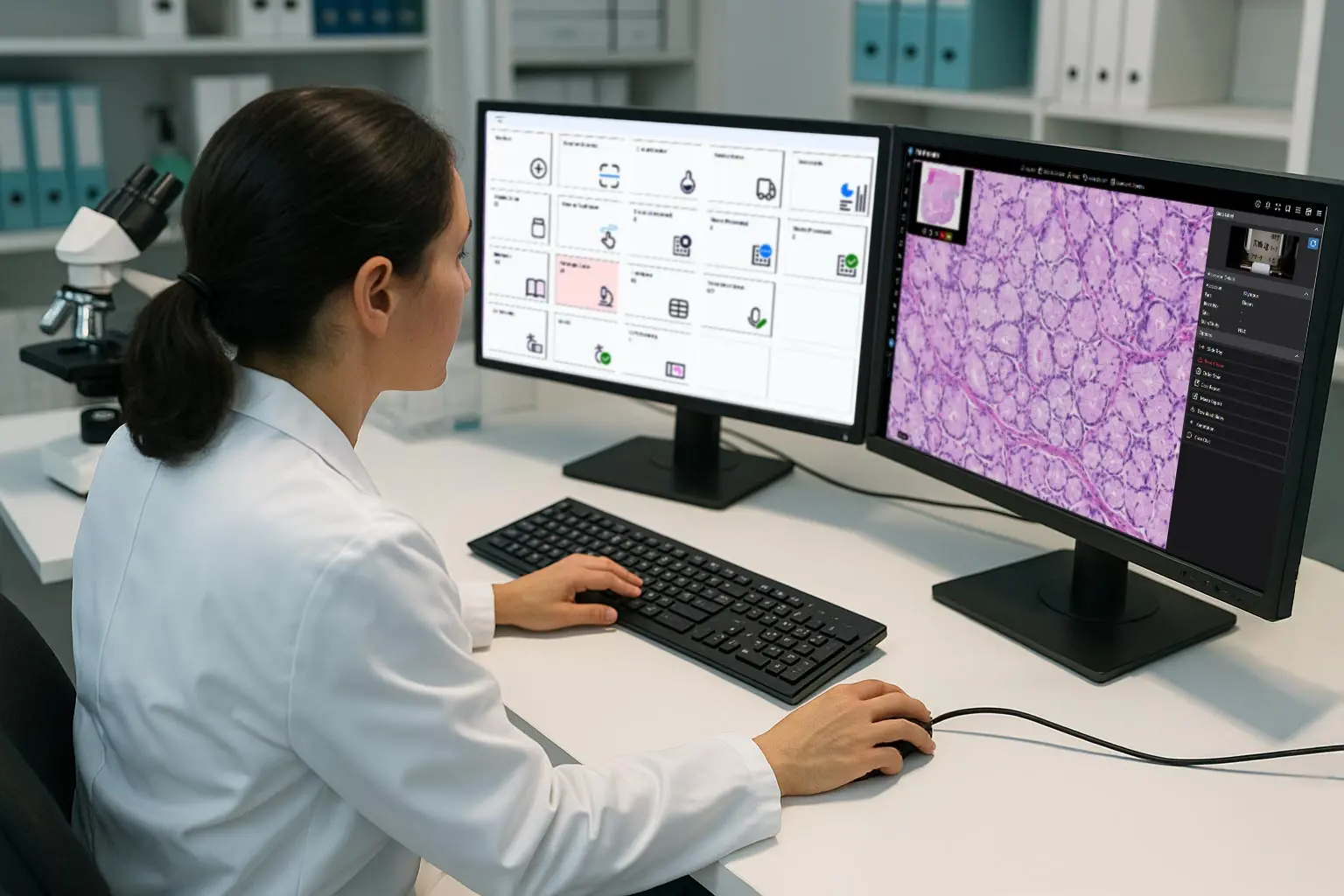Blog
Why LigoLab’s LIS System Implementation Model Outpaces Legacy Lab Vendors
August 14, 2025
Rolling out a new laboratory information system (LIS software) is one of the most critical and high-stakes undertakings for any medical lab. Done right, it can fast-track operational excellence; done poorly, it can trigger months of costly disruption.
Legacy LIS lab vendors often rely on a slow, step-by-step process that delays results and frustrates staff. LigoLab takes a different path, using a structured-for-scale approach with four expert-led workstreams running in parallel from day one. The outcome is a faster, more coordinated launch, minimal downtime, and a platform that feels custom-built for your lab the moment it goes live.
What follows is a side-by-side comparison of LigoLab’s modern approach versus what to expect from traditional laboratory information system companies.
Discover More: Not All LIS Systems Are Created Equally
The Legacy LIS Implementation Model: Sequential, Siloed, and Risk-Prone
Before exploring LigoLab’s modern approach, it’s worth reviewing the typical legacy LIS system implementation model, a long-standing industry practice that has seen little evolution over the years.
Common Characteristics of Legacy LIS System Implementations:
Linear Project Flow - Configuration, integration, data migration, and custom development flow one after another, often with idle time between phases.
Minimal Early Discovery - Limited up-front workflow analysis means issues often surface late in the process, requiring rework and delays.
Slow Environment Setup - Weeks (or months) can pass before the lab even sees its new LIS software environment.
Outsourced or Part-Time Teams - Key tasks may be handled by contractors unfamiliar with the lab’s needs or the LIS vendor’s full capabilities.
Interface Development Bottlenecks - Integrations with instruments, electronic health record systems, or laboratory billing systems are often left until the end, creating go-live risks.
Incomplete Data Migration - Legacy LIS software vendors may import only minimal historical data, forcing staff to utilize multiple systems, at least for some time, after go-live.
Delayed Customization - Feature requests are often handled post-launch, leaving labs to adapt to missing functionality in the short term.
Although it ultimately works, the legacy approach lengthens the transition, increases operational risk, and forces labs to modify their workflows to fit the new LIS system rather than having the system adapt to them.
White Paper: Transitioning from CoPath to LigoLab - A Seamless Path to LIS System Modernization

The LigoLab Approach: Four Parallel Workstreams from Day One
LigoLab takes the opposite approach. Instead of working through tasks sequentially, LigoLab activates four coordinated workstreams immediately after the contract signing. This parallel structure is designed for speed, accuracy, and minimal disruption without sacrificing quality.
Day 1 Momentum: Fast Setup and Early Discovery
Within 48 hours of contract signing, your dedicated LigoLab LIS environment is provisioned. A kickoff call aligns stakeholders, timelines, and next steps. Shortly after, LigoLab conducts an on-site domain discovery with every department to document workflows, identify inefficiencies, and create a detailed implementation blueprint.
Unlike the legacy model, this phase ensures every requirement and dependency is known upfront, preventing downstream surprises.
Discover More: Best Practices Guide - Managing LIS System Timelines for Vendor Research and Implementation
Workstream 1: Implementation & Validation
- Works directly with your lab staff, department by department.
- Configures the LIS system to match your current workflows, then optimizes them.
- Trains superusers first in a live sandbox environment, then expands training to all staff.
- Validates workflows continuously, ensuring that by go-live, the lab information system is already part of your team’s muscle memory.
Legacy Difference:
Traditional laboratory information system vendors often configure the LIS software in isolation and provide training only near go-live, leaving staff underprepared.
Workstream 2: Integration
- Builds bi-directional connections to instruments, EHRs, laboratory billing systems, CSMs, reference labs, state reporting portals, and other third-party lab vendors.
- Runs interface testing in parallel with LIS system configuration, so integrations are stable before launch.
- Eliminates the “integration crunch” that plagues legacy go-lives.
Legacy Difference:
Interfaces are often developed last, creating cascading delays and forcing labs to use manual workarounds in the interim.
Workstream 3: Data Migration
LigoLab’s three-phase migration ensures complete historical continuity and data integrity:
- Historical Export - Imports up to 10 years of past data for full longitudinal visibility.
- Catch-Up Import - Near go-live, adds records captured during implementation.
- Final Sync - 2–3 months post go-live, reconciles all data for 100 percent accuracy.
Legacy Difference:
Many legacy laboratory information system companies migrate minimal or incomplete data, requiring staff to maintain access to the old LIS system and undermining operational efficiency.
Workstream 4: Engineering
- Develops any custom features identified during discovery in parallel with configuration.
- Particularly valuable for enterprise labs replacing multiple legacy LIS systems.
- Integrates all functionality pre-launch so the informatics platform is “fully loaded” on day one.
Legacy Difference:
Custom development is often delayed until after launch, forcing labs to adapt to missing features or operate with workarounds.
Discover More: Keys to Keeping Your LIS System Implementation on Track

Why Parallel Workstreams Matter
By running all four workstreams in parallel, the timeline is shortened without sacrificing quality. Each is led by dedicated specialists and kept in sync through:
- Regular Check-Ins - Keeping progress transparent and aligned.
- Dedicated Success Lead - Ensuring accountability and coordination across teams.
- Blueprint-Driven Execution - Sticking to a documented, agreed-upon plan.
The payoff is clear:
- Faster Time-to-Value - Your lab benefits from the new LIS software sooner.
Reduced Risk - Issues are addressed early, not at go-live. - Tailor-Made Fit - The LIS system is built around your specific workflows, not forced into a one-size-fits-all mold.
Customer Impact: Faster, Safer, Smarter Implementations
Labs that implement with LigoLab report:
- Shorter project timelines (often by months).
- Higher staff confidence at go-live.
- Fewer post-launch fixes and workflow disruptions.
- Seamless data continuity without reliance on old systems.
Discover More: LigoLab’s Approach to LIS System Implementation and Support
The Bottom Line
The world of laboratory operations is high-stakes, and an LIS implementation is both a technical process and a business-critical transformation. LIS system vendors too often treat it as a slow, one-size-fits-all project.
LigoLab’s Structured-for-Scale approach recognizes that labs can’t afford extended downtime or half-functional launches. By activating four specialized teams in parallel (implementation, integration, migration, and engineering), LigoLab delivers a fully integrated, fully optimized LIS medical solution that’s ready for your entire operation on day one.
Discover More: Stability and Performance - The Two Most Important Aspects of a Modern Laboratory Operation
Ready to see the difference a parallel, expert-driven lab information system implementation can make for your lab?
Request a personalized LIS software demo and discover how LigoLab’s approach minimizes risk, maximizes ROI, and gets your lab to peak performance faster than you thought possible.






